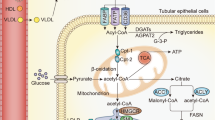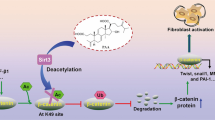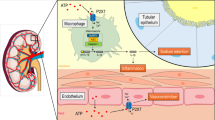Abstract
Aim:
To explore the signal transducer and activator of transcription 3 (STAT3) signaling pathway, especially STAT3 acetylation, in angiotensin II (Ang II)-induced pro-fibrotic responses in renal tubular epithelial cells.
Methods:
Rat renal tubular epithelial cell line (NRK-52E) was used. STAT3 acetylation and phosphorylation, as well as the expression of fibronectin, collagen IV and transforming growth factor-β1 (TGF-β1) were examined using Western blotting. The level and localization of STAT3 phosphorylation on Tyr705 were detected with fluorescence immunocytochemistry. The cells were transfected with a plasmid vector carrying p300 gene or siRNA targeting p300 to regulate p300 expression.
Results:
Overexpression of p300 significantly increased STAT3 acetylation on Lys685, STAT3 phosphorylation on Tyr705, and the expression of TGF-β1, collagen IV and fibronectin in the cells. Treatment of the cells with Ang II (1 μmol/L) significantly increased STAT3 phosphorylation on Tyr705 through JAK2 activation, and dose-dependently increased the expression of fibronectin, collagen IV and TGF-β1. Pretreatment with curcumin, an inhibitor of JAK2 and p300, blocked Ang II-induced effects. Knockdown of p300 significantly decreased STAT3 acetylation on Lys685, and abolished Ang II-stimulated STAT3 phosphorylation on Tyr705, whereas pretreatment of the cells with C646, a selective inhibitor of p300, inhibited Ang II-induced STAT3 nuclear translocation and the expression of TGF-β1, collagen IV and fibronectin. Pretreatment of the cells with AG490, a JAK2 inhibitor, markedly inhibited Ang II-induced STAT3 phosphorylation on Tyr705 and fibronectin expression.
Conclusion:
p300-dependent STAT3 acetylation is necessary for Ang II-induced STAT3 phosphorylation and the consequent pro-fibrotic responses in renal tubular epithelial cells in vitro.
Similar content being viewed by others
Log in or create a free account to read this content
Gain free access to this article, as well as selected content from this journal and more on nature.com
or
References
Eddy AA . The STAT3 NH2-terminal domain stabilizes enhanceosome assembly by interacting with the p300 bromodomain. Adv Chronic Kidney Dis 2005; 12: 353–65.
Liu Y . Renal fibrosis: new insights into the pathogenesis and therapeutics. Kidney Int 2006; 69: 213–7.
Matsui F, Rhee A, Hile KL, Zhang H, Meldrum KK . IL-18 induces profibrotic renal tubular cell injury via STAT3 activation. Am J Physiol Renal Physiol 2013; 305: F1014–F1021.
Iwano M, Plieth D, Danoff TM, Xue C, Okada H, Neilson EG . Evidence that fibroblasts derive from epithelium during tissue fibrosis. J Clin Invest 2002; 110: 341–50.
Liu Y . Epithelial to mesenchymal transition in renal fibrogenesis: pathologic significance, molecular mechanism, and therapeutic intervention. J Am Soc Nephrol 2004; 15: 1–12.
Rastaldi MP, Ferrario F, Giardino L, Dell'Antonio G, Grillo C, Grillo P, et al. Epithelial-mesenchymal transition of tubular epithelial cells in human renal biopsies. Kidney Int 2002; 62: 137–46.
Zeisberg M, Hanai J, Sugimoto H, Mammoto T, Charytan D, Strutz F, et al. BMP-7 counteracts TGF-beta1-induced epithelial-to-mesenchymal transition and reverses chronic renal injury. Nat Med 2003; 9: 964–8.
Ivanova L, Butt MJ, Matsell DG . Mesenchymal transition in kidney collecting duct epithelial cells. Am J Physiol Renal Physiol 2008; 294: F1238–F1248.
Ranganathan P, Jayakumar C, Ramesh G . Proximal tubule-specific overexpression of netrin-1 suppresses acute kidney injury-induced interstitial fibrosis and glomerulosclerosis through suppression of IL-6/STAT3 signaling. Am J Physiol Renal Physiol 2013; 304: F1054–F1065.
Zhong J, Guo D, Chen CB, Wang W, Schuster M, Loibner H, et al. Prevention of angiotensin II-mediated renal oxidative stress, inflammation, and fibrosis by angiotensin-converting enzyme 2. Hypertension 2011; 57: 314–22.
Li YQ, Li XB, Guo SJ, Chu SL, Gao PJ, Zhu DL, et al. Apocynin attenuates oxidative stress and cardiac fibrosis in angiotensin II-induced cardiac diastolic dysfunction in mice. Acta Pharmacol Sin 2013; 34: 352–9.
Uchida Y, Miyajima A, Kikuchi E, Kozakai N, Kosaka T, Ieda M, et al. Renal damage inhibited in mice lacking angiotensinogen gene subjected to unilateral ureteral obstruction. Urology 2009; 74: 938–43.
Grande MT, Perez-Barriocanal F, Lopez-Novoa JM . Role of inflammation in tubulo-interstitial damage associated to obstructive nephropathy. J Inflamm (Lond) 2010; 7: 19.
Tang SC, Lai KN . The pathogenic role of the renal proximal tubular cell in diabetic nephropathy. Nephrol Dial Transplant 2012; 27: 3049–56.
Schindler CW . Series introduction. JAK-STAT signaling in human disease. J Clin Invest 2002; 109: 1133–7.
Kodama H, Fukuda K, Pan J, Makino S, Sano M, Takahashi T, et al. Biphasic activation of the JAK/STAT pathway by angiotensin II in rat cardiomyocytes. Circ Res 1998; 82: 244–50.
Weng YI, Aroor AR, Shukla SD . Ethanol inhibition of angiotensin II-stimulated Tyr705 and Ser727 STAT3 phosphorylation in cultured rat hepatocytes: relevance to activation of p42/44 mitogen-activated protein kinase. Alcohol 2008; 42: 397–406.
Kandalam U, Clark MA . Angiotensin II activates JAK2/STAT3 pathway and induces interleukin-6 production in cultured rat brainstem astrocytes. Regul Pept 2010; 159: 110–6.
Amiri F, Shaw S, Wang X, Tang J, Waller JL, Eaton DC, et al. Angiotensin II activation of the JAK/STAT pathway in mesangial cells is altered by high glucose. Kidney Int 2002; 61: 1605–16.
Chen X, Wang J, Zhou F, Wang X, Feng Z . STAT proteins mediate angiotensin II-induced production of TIMP-1 in human proximal tubular epithelial cells. Kidney Int 2003; 64: 459–67.
Bromberg J, Darnell JJ . The role of STATs in transcriptional control and their impact on cellular function. Oncogene 2000; 19: 2468–73.
Liu DB, Hu GY, Long GX, Qiu H, Mei Q, Hu GQ . Celecoxib induces apoptosis and cell-cycle arrest in nasopharyngeal carcinoma cell lines via inhibition of STAT3 phosphorylation. Acta Pharmacol Sin 2012; 33: 682–90.
Kuratsune M, Masaki T, Hirai T, Kiribayashi K, Yokoyama Y, Arakawa T, et al. Signal transducer and activator of transcription 3 involvement in the development of renal interstitial fibrosis after unilateral ureteral obstruction. Nephrology (Carlton) 2007; 12: 565–71.
Pang M, Kothapally J, Mao H, Tolbert E, Ponnusamy M, Chin YE, et al. Inhibition of histone deacetylase activity attenuates renal fibroblast activation and interstitial fibrosis in obstructive nephropathy. Am J Physiol Renal Physiol 2009; 297: F996–F1005.
Liu N, Guo JK, Pang M, Tolbert E, Ponnusamy M, Gong R, et al. Genetic or pharmacologic blockade of EGFR inhibits renal fibrosis. J Am Soc Nephrol 2012; 23: 854–67.
Wen Z, Zhong Z, Darnell JJ . Maximal activation of transcription by Stat1 and Stat3 requires both tyrosine and serine phosphorylation. Cell 1995; 82: 241–50.
Wang R, Cherukuri P, Luo J . Activation of Stat3 sequence-specific DNA binding and transcription by p300/CREB-binding protein-mediated acetylation. J Biol Chem 2005; 280: 11528–34.
Yuan Z L, Guan Y J, Chatterjee D, Chin YE . Stat3 dimerization regulated by reversible acetylation of a single lysine residue. Science 2005; 307: 269–73.
Ray S, Sherman CT, Lu M, Brasier AR . Angiotensinogen gene expression is dependent on signal transducer and activator of transcription 3-mediated p300/cAMP response element binding protein-binding protein coactivator recruitment and histone acetyltransferase activity. Mol Endocrinol 2002; 16: 824–36.
Huang C, Han Y, Wang Y, Sun X, Yan S, Yeh ET, et al. SENP3 is responsible for HIF-1 transactivation under mild oxidative stress via p300 de-SUMOylation. EMBO J 2009; 28: 2748–62.
Wang Y, Yang J, Yang K, Cang H, Huang XZ, Li H, et al. The biphasic redox sensing of SENP3 accounts for the HIF-1 transcriptional activity shift by oxidative stress. Acta Pharmacol Sin 2012; 33: 953–63.
Hou T, Ray S, Lee C, Brasier AR . The STAT3 NH2-terminal domain stabilizes enhanceosome assembly by interacting with the p300 bromodomain. J Biol Chem 2008; 283: 30725–34.
Kaur H, Chen S, Xin X, Chiu J, Khan ZA, Chakrabarti S . Diabetes-induced extracellular matrix protein expression is mediated by transcription coactivator p300. Diabetes 2006; 55: 3104–11.
Chiu J, Khan ZA, Farhangkhoee H, Chakrabarti S . Curcumin prevents diabetes-associated abnormalities in the kidneys by inhibiting p300 and nuclear factor-kappaB. Nutrition 2009; 25: 964–72.
Chen S, Feng B, George B, Chakrabarti R, Chen M, Chakrabarti S . Transcriptional coactivator p300 regulates glucose-induced gene expression in endothelial cells. Am J Physiol Endocrinol Metab 2010; 298: E127–E137.
Feng B, Chen S, Mcarthur K, Wu Y, Sen S, Ding Q, et al. miR-146a-Mediated extracellular matrix protein production in chronic diabetes complications. Diabetes 2011; 60: 2975–84.
Hua P, Feng W, Rezonzew G, Chumley P, Jaimes EA . The transcription factor ETS-1 regulates angiotensin II-stimulated fibronectin production in mesangial cells. Am J Physiol Renal Physiol 2012; 302: F1418–F1429.
Sestito R, Madonna S, Scarponi C, Cianfarani F, Failla CM, Cavani A, et al. STAT3-dependent effects of IL-22 in human keratinocytes are counterregulated by sirtuin 1 through a direct inhibition of STAT3 acetylation. FASEB J 2011; 25: 916–27.
Jain S, Wei J, Mitrani LR, Bishopric NH . Auto-acetylation stabilizes p300 in cardiac myocytes during acute oxidative stress, promoting STAT3 accumulation and cell survival. Breast Cancer Res Treat 2012; 135: 103–14.
Scuto A, Kirschbaum M, Buettner R, Kujawski M, Cermak JM, Atadja P, et al. SIRT1 activation enhances HDAC inhibition-mediated upregulation of GADD45G by repressing the binding of NF-kappaB/STAT3 complex to its promoter in malignant lymphoid cells. Cell Death Dis 2013; 4: e635.
Sethi G, Chatterjee S, Rajendran P, Li F, Shanmugam MK, Wong K F, et al. Inhibition of STAT3 dimerization and acetylation by garcinol suppresses the growth of human hepatocellular carcinoma in vitro and in vivo. Mol Cancer 2014; 13: 66.
Pang M, Ma L, Liu N, Ponnusamy M, Zhao TC, Yan H, et al. Histone deacetylase 1/2 mediates proliferation of renal interstitial fibroblasts and expression of cell cycle proteins. J Cell Biochem 2011; 112: 2138–48.
Ni J, Shen Y, Wang Z, Shao DC, Liu J, Fu LJ, et al. STAT3 acetylation is associated with angiotesin II-induced murine renal fibrosis. Acta Pharmacol Sin 2014; 35: 1045–54.
He M, Zhang L, Shao Y, Xue H, Zhou L, Wang XF, et al. Angiotensin II type 2 receptor mediated angiotensin II and high glucose induced decrease in renal prorenin/renin receptor expression. Mol Cell Endocrinol 2010; 315: 188–94.
Marcu MG, Jung YJ, Lee S, Chung EJ, Lee MJ, Trepel J, et al. Curcumin is an inhibitor of p300 histone acetylatransferase. Med Chem 2006; 2: 169–74.
Sunagawa Y, Morimoto T, Wada H, Takaya T, Katanasaka Y, Kawamura T, et al. A natural p300-specific histone acetyltransferase inhibitor, curcumin, in addition to angiotensin-converting enzyme inhibitor, exerts beneficial effects on left ventricular systolic function after myocardial infarction in rats. Circ J 2011; 75: 2151–9.
Kim HY, Park EJ, Joe EH, Jou I . Curcumin suppresses Janus kinase-STAT inflammatory signaling through activation of Src homology 2 domain-containing tyrosine phosphatase 2 in brain microglia. J Immunol 2003; 171: 6072–9.
Duan W, Yang Y, Yan J, Yu S, Liu J, Zhou J, et al. The effects of curcumin post-treatment against myocardial ischemia and reperfusion by activation of the JAK2/STAT3 signaling pathway. Basic Res Cardiol 2012; 107: 263.
Hendrayani SF, Al-Khalaf HH, Aboussekhra A . Curcumin triggers p16-dependent senescence in active breast cancer-associated fibroblasts and suppresses their paracrine procarcinogenic effects. Neoplasia 2013; 15: 631–40.
Bowers EM, Yan G, Mukherjee C, Orry A, Wang L, Holbert MA, et al. Virtual ligand screening of the p300/CBP histone acetyltransferase: identification of a selective small molecule inhibitor. Chem Biol 2010; 17: 471–82.
Gao XN, Lin J, Ning QY, Gao L, Yao YS, Zhou JH, et al. A histone acetyltransferase p300 inhibitor C646 induces cell cycle arrest and apoptosis selectively in AML1-ETO-positive AML cells. PLoS One 2013; 8: e 55481.
Yan G, Eller MS, Elm C, Larocca CA, Ryu B, Panova IP, et al. Selective inhibition of p300 HAT blocks cell cycle progression, induces cellular senescence, and inhibits the DNA damage response in melanoma cells. J Invest Dermatol 2013; 133: 2444–52.
Meydan N, Grunberger T, Dadi H, Shahar M, Arpaia E, Lapidot Z, et al. Inhibition of acute lymphoblastic leukaemia by a Jak-2 inhibitor. Nature 1996; 379: 645–8.
De Vos J, Jourdan M, Tarte K, Jasmin C, Klein B . JAK2 tyrosine kinase inhibitor tyrphostin AG490 downregulates the mitogen-activated protein kinase (MAPK) and signal transducer and activator of transcription (STAT) pathways and induces apoptosis in myeloma cells. Br J Haematol 2000; 109: 823–8.
Qian C, Wang J, Yao J, Wang L, Xue M, Liu W, et al. Involvement of nuclear JAK2 signaling in AG490-induced apoptosis of gastric cancer cells. Anat Rec (Hoboken) 2013; 296: 1865–73.
Guo D, Li JR, Wang Y, Lei L S, Yu CL, Chen NN . Cyclovirobuxinum D suppresses lipopolysaccharide-induced inflammatory responses in murine macrophages in vitro by blocking JAK-STAT signaling pathway. Acta Pharmacol Sin 2014; 35: 770–8.
Ray S, Boldogh I, Brasier AR . STAT3 NH2-terminal acetylation is activated by the hepatic acute-phase response and required for IL-6 induction of angiotensinogen. Gastroenterology 2005; 129: 1616–32.
Acknowledgements
This research was financially supported by the National Natural Science Foundation of China to Li-min LU (No 81070577, 81170636), Hong XUE (No 81000280), Wei ZHANG (No 81100531) and Chen YU (No 81070547).
Author information
Authors and Affiliations
Corresponding authors
Rights and permissions
About this article
Cite this article
Ni, J., Shen, Y., Wang, Z. et al. P300-dependent STAT3 acetylation is necessary for angiotensin II-induced pro-fibrotic responses in renal tubular epithelial cells. Acta Pharmacol Sin 35, 1157–1166 (2014). https://doi.org/10.1038/aps.2014.54
Received:
Accepted:
Published:
Issue date:
DOI: https://doi.org/10.1038/aps.2014.54
Keywords
This article is cited by
-
Regulation of epithelial-mesenchymal transition by protein lysine acetylation
Cell Communication and Signaling (2022)
-
Acetylation of ELF5 suppresses breast cancer progression by promoting its degradation and targeting CCND1
npj Precision Oncology (2021)
-
3-deazaneplanocin A protects against cisplatin-induced renal tubular cell apoptosis and acute kidney injury by restoration of E-cadherin expression
Cell Death & Disease (2019)
-
Clostridium butyricum in combination with specific immunotherapy converts antigen-specific B cells to regulatory B cells in asthmatic patients
Scientific Reports (2016)
-
N-acetylcysteine alleviates angiotensin II-mediated renal fibrosis in mouse obstructed kidneys
Acta Pharmacologica Sinica (2016)



